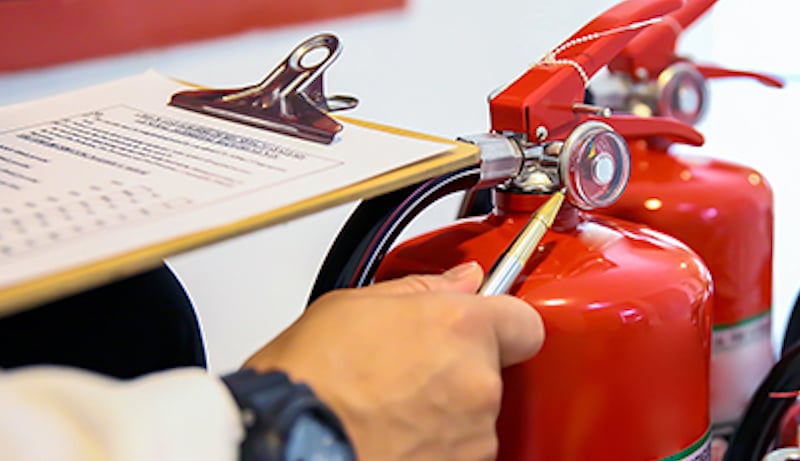Class K Fire Extinguishers for Kitchens
by Brothers Fire & Security | May 8, 2023 | Fire System | 0 comments

Kitchen fires are a very common hazard that seriously threatens safety in commercial kitchens. Every second counts in the event of a kitchen fire. It’s imperative to act quickly to safely extinguish the flames to prevent the fire from spreading. That’s why it’s important to have a Class K fire extinguisher in an easily accessible location at all times in your restaurant, industrial kitchen, or food truck.
What Is a Class K Fire Extinguisher?
If you run a restaurant business of any kind, it's crucial to have the suitable fire extinguisher on hand for several reasons. For one, not all extinguishers serve the same purpose or are designed to put out the same fires. Using the wrong fire extinguisher can be ineffective and can even add fuel to the fire in certain situations.
Resource: Ultimate guide to fire extinguishers
A Class K extinguisher is a special fire extinguisher specifically designed to extinguish kitchen fires involving cooking oils, greases, and fats. These fires are classified as Class K fires. They can be particularly dangerous and difficult to put out due to the high heat and volatility of the cooking oils, greases, and fats. Class K fires also tend to spread rapidly due to the flammability of cooking oils and fats. A Class K fire extinguisher is essential for effectively extinguishing kitchen fires as they greatly minimize the risk of personal injury and property damage.
How Do Class K Fire Extinguishers Work?
Class K fire extinguishers work through “saponification”—a chemical process that involves the formation of soap through the reaction of an acid with a base.
Potassium acetate is a common extinguishing agent in Class K extinguishers. It reacts with the cooking oils or fats to form a soap that can envelop and smother the burning fuel. The process breaks down the fire's fuel source, disrupts the chemical reaction causing the fire and cools down the area to prevent re-ignition.
Resource: 4 things to know about kitchen hood maintenance
Installing and Inspecting Class K Fire Extinguishers
Installing a Class K fire extinguisher is vital in protecting your restaurant, industrial kitchen or food truck from fires. By following these best practices, you can ensure that your fire extinguisher is ready to use in the event of an emergency:
- Keep the extinguisher within reach: Fire extinguishers should be easily accessible and visible at all times.
- Follow local codes and regulations: These codes may vary depending on your jurisdiction, so it is essential to check with your local fire department, fire marshal or other authorities having jurisdiction, (AHJ).
- Train staff on proper use: Training should include instruction on identifying a Class K fire, activating the extinguisher, and properly aiming and discharging the extinguisher.
- Test and inspect the extinguisher regularly.
Here’s how you can inspect your Class K fire extinguisher to ensure it’s in good working order.
- Check the pressure gauge and inspect the nozzle and hose: Ensure that the pressure gauge is in the green zone, indicating that the extinguisher is at the proper fuel level. The extinguisher needs to be recharged or replaced if the indicator is in either red zone.
- Inspect the nozzle and check the discharge mechanism: The nozzle should be clear of any debris. If the nozzle is clogged, the extinguisher may not function properly when you need it to.
- Check the expiration date: Class K extinguishers must be inspected every year and recharged every five years. If the extinguisher is past 12 years, we recommend it be replaced.
- Check the mounting bracket: Make sure that the bracket is in good condition and the extinguisher is properly secured to prevent it from becoming an added risk to health and safety.
Is Your Commercial Kitchen Prepared?
Keep a Class K fire extinguisher in an easily accessible location in the kitchen, and be sure to familiarize yourself and your staff with how to properly use it. If a fire occurs and grows too large or out of control, immediately evacuate the building and call 911.
Following these best practices can help ensure that your restaurant, industrial kitchen, or food truck is effectively prepared.
Brothers Fire & Security Monitoring can assist you with testing, maintaining, and refilling any fire extinguisher. Contact us to figure out the best fire prevention system for your building.
Recent Posts
- Hidden Risks: Why Aging Fire Systems Need More Than Just Annual Inspections
- Strategic Security Camera Placement: Maximizing Protection Through Integration
- Why NFPA 72 Makes Integrated Fire & Security Monitoring Systems Essential
- Benefits of a Building Access Control System
- Ultimate Guide to Fire Extinguishers: Testing, Inspections, Maintenance

